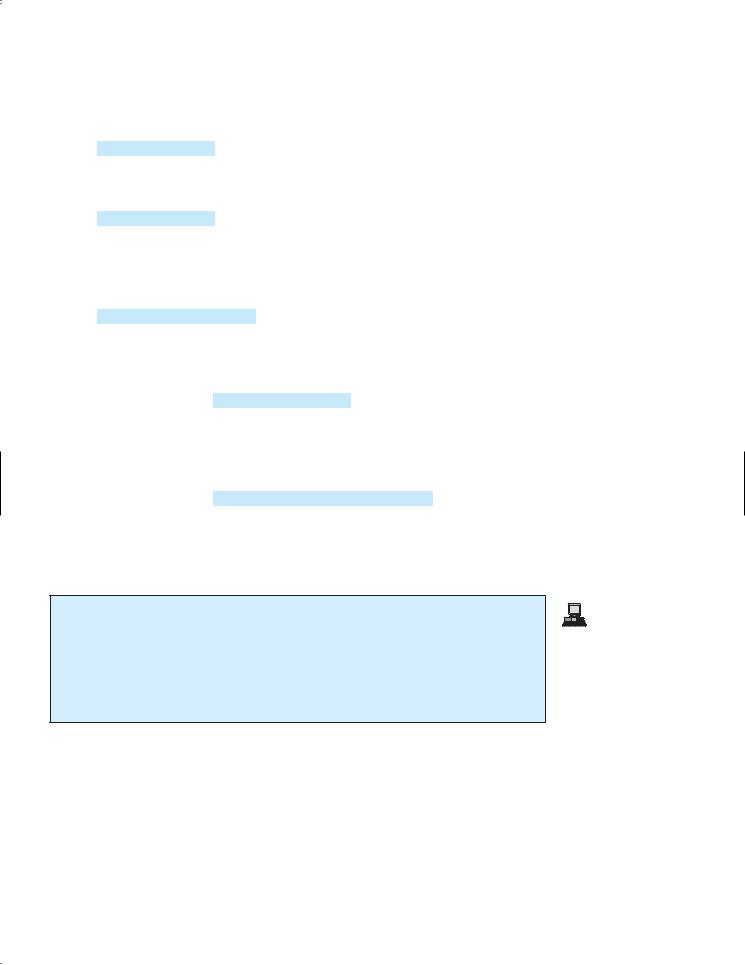
- •CONTENTS
- •1.1 Introduction
- •1.2 What Is a Computer?
- •1.3 Programs
- •1.4 Operating Systems
- •1.5 Java, World Wide Web, and Beyond
- •1.6 The Java Language Specification, API, JDK, and IDE
- •1.7 A Simple Java Program
- •1.8 Creating, Compiling, and Executing a Java Program
- •1.9 (GUI) Displaying Text in a Message Dialog Box
- •2.1 Introduction
- •2.2 Writing Simple Programs
- •2.3 Reading Input from the Console
- •2.4 Identifiers
- •2.5 Variables
- •2.7 Named Constants
- •2.8 Numeric Data Types and Operations
- •2.9 Problem: Displaying the Current Time
- •2.10 Shorthand Operators
- •2.11 Numeric Type Conversions
- •2.12 Problem: Computing Loan Payments
- •2.13 Character Data Type and Operations
- •2.14 Problem: Counting Monetary Units
- •2.15 The String Type
- •2.16 Programming Style and Documentation
- •2.17 Programming Errors
- •2.18 (GUI) Getting Input from Input Dialogs
- •3.1 Introduction
- •3.2 boolean Data Type
- •3.3 Problem: A Simple Math Learning Tool
- •3.4 if Statements
- •3.5 Problem: Guessing Birthdays
- •3.6 Two-Way if Statements
- •3.7 Nested if Statements
- •3.8 Common Errors in Selection Statements
- •3.9 Problem: An Improved Math Learning Tool
- •3.10 Problem: Computing Body Mass Index
- •3.11 Problem: Computing Taxes
- •3.12 Logical Operators
- •3.13 Problem: Determining Leap Year
- •3.14 Problem: Lottery
- •3.15 switch Statements
- •3.16 Conditional Expressions
- •3.17 Formatting Console Output
- •3.18 Operator Precedence and Associativity
- •3.19 (GUI) Confirmation Dialogs
- •4.1 Introduction
- •4.2 The while Loop
- •4.3 The do-while Loop
- •4.4 The for Loop
- •4.5 Which Loop to Use?
- •4.6 Nested Loops
- •4.7 Minimizing Numeric Errors
- •4.8 Case Studies
- •4.9 Keywords break and continue
- •4.10 (GUI) Controlling a Loop with a Confirmation Dialog
- •5.1 Introduction
- •5.2 Defining a Method
- •5.3 Calling a Method
- •5.4 void Method Example
- •5.5 Passing Parameters by Values
- •5.6 Modularizing Code
- •5.7 Problem: Converting Decimals to Hexadecimals
- •5.8 Overloading Methods
- •5.9 The Scope of Variables
- •5.10 The Math Class
- •5.11 Case Study: Generating Random Characters
- •5.12 Method Abstraction and Stepwise Refinement
- •6.1 Introduction
- •6.2 Array Basics
- •6.3 Problem: Lotto Numbers
- •6.4 Problem: Deck of Cards
- •6.5 Copying Arrays
- •6.6 Passing Arrays to Methods
- •6.7 Returning an Array from a Method
- •6.8 Variable-Length Argument Lists
- •6.9 Searching Arrays
- •6.10 Sorting Arrays
- •6.11 The Arrays Class
- •7.1 Introduction
- •7.2 Two-Dimensional Array Basics
- •7.3 Processing Two-Dimensional Arrays
- •7.4 Passing Two-Dimensional Arrays to Methods
- •7.5 Problem: Grading a Multiple-Choice Test
- •7.6 Problem: Finding a Closest Pair
- •7.7 Problem: Sudoku
- •7.8 Multidimensional Arrays
- •8.1 Introduction
- •8.2 Defining Classes for Objects
- •8.3 Example: Defining Classes and Creating Objects
- •8.4 Constructing Objects Using Constructors
- •8.5 Accessing Objects via Reference Variables
- •8.6 Using Classes from the Java Library
- •8.7 Static Variables, Constants, and Methods
- •8.8 Visibility Modifiers
- •8.9 Data Field Encapsulation
- •8.10 Passing Objects to Methods
- •8.11 Array of Objects
- •9.1 Introduction
- •9.2 The String Class
- •9.3 The Character Class
- •9.4 The StringBuilder/StringBuffer Class
- •9.5 Command-Line Arguments
- •9.6 The File Class
- •9.7 File Input and Output
- •9.8 (GUI) File Dialogs
- •10.1 Introduction
- •10.2 Immutable Objects and Classes
- •10.3 The Scope of Variables
- •10.4 The this Reference
- •10.5 Class Abstraction and Encapsulation
- •10.6 Object-Oriented Thinking
- •10.7 Object Composition
- •10.8 Designing the Course Class
- •10.9 Designing a Class for Stacks
- •10.10 Designing the GuessDate Class
- •10.11 Class Design Guidelines
- •11.1 Introduction
- •11.2 Superclasses and Subclasses
- •11.3 Using the super Keyword
- •11.4 Overriding Methods
- •11.5 Overriding vs. Overloading
- •11.6 The Object Class and Its toString() Method
- •11.7 Polymorphism
- •11.8 Dynamic Binding
- •11.9 Casting Objects and the instanceof Operator
- •11.11 The ArrayList Class
- •11.12 A Custom Stack Class
- •11.13 The protected Data and Methods
- •11.14 Preventing Extending and Overriding
- •12.1 Introduction
- •12.2 Swing vs. AWT
- •12.3 The Java GUI API
- •12.4 Frames
- •12.5 Layout Managers
- •12.6 Using Panels as Subcontainers
- •12.7 The Color Class
- •12.8 The Font Class
- •12.9 Common Features of Swing GUI Components
- •12.10 Image Icons
- •13.1 Introduction
- •13.2 Exception-Handling Overview
- •13.3 Exception-Handling Advantages
- •13.4 Exception Types
- •13.5 More on Exception Handling
- •13.6 The finally Clause
- •13.7 When to Use Exceptions
- •13.8 Rethrowing Exceptions
- •13.9 Chained Exceptions
- •13.10 Creating Custom Exception Classes
- •14.1 Introduction
- •14.2 Abstract Classes
- •14.3 Example: Calendar and GregorianCalendar
- •14.4 Interfaces
- •14.5 Example: The Comparable Interface
- •14.6 Example: The ActionListener Interface
- •14.7 Example: The Cloneable Interface
- •14.8 Interfaces vs. Abstract Classes
- •14.9 Processing Primitive Data Type Values as Objects
- •14.10 Sorting an Array of Objects
- •14.11 Automatic Conversion between Primitive Types and Wrapper Class Types
- •14.12 The BigInteger and BigDecimal Classes
- •14.13 Case Study: The Rational Class
- •15.1 Introduction
- •15.2 Graphical Coordinate Systems
- •15.3 The Graphics Class
- •15.4 Drawing Strings, Lines, Rectangles, and Ovals
- •15.5 Case Study: The FigurePanel Class
- •15.6 Drawing Arcs
- •15.7 Drawing Polygons and Polylines
- •15.8 Centering a String Using the FontMetrics Class
- •15.9 Case Study: The MessagePanel Class
- •15.10 Case Study: The StillClock Class
- •15.11 Displaying Images
- •15.12 Case Study: The ImageViewer Class
- •16.1 Introduction
- •16.2 Event and Event Source
- •16.3 Listeners, Registrations, and Handling Events
- •16.4 Inner Classes
- •16.5 Anonymous Class Listeners
- •16.6 Alternative Ways of Defining Listener Classes
- •16.7 Problem: Loan Calculator
- •16.8 Window Events
- •16.9 Listener Interface Adapters
- •16.10 Mouse Events
- •16.11 Key Events
- •16.12 Animation Using the Timer Class
- •17.1 Introduction
- •17.2 Buttons
- •17.3 Check Boxes
- •17.4 Radio Buttons
- •17.5 Labels
- •17.6 Text Fields
- •17.7 Text Areas
- •17.8 Combo Boxes
- •17.9 Lists
- •17.10 Scroll Bars
- •17.11 Sliders
- •17.12 Creating Multiple Windows
- •18.1 Introduction
- •18.2 Developing Applets
- •18.3 The HTML File and the <applet> Tag
- •18.4 Applet Security Restrictions
- •18.5 Enabling Applets to Run as Applications
- •18.6 Applet Life-Cycle Methods
- •18.7 Passing Strings to Applets
- •18.8 Case Study: Bouncing Ball
- •18.9 Case Study: TicTacToe
- •18.10 Locating Resources Using the URL Class
- •18.11 Playing Audio in Any Java Program
- •18.12 Case Study: Multimedia Animations
- •19.1 Introduction
- •19.2 How is I/O Handled in Java?
- •19.3 Text I/O vs. Binary I/O
- •19.4 Binary I/O Classes
- •19.5 Problem: Copying Files
- •19.6 Object I/O
- •19.7 Random-Access Files
- •20.1 Introduction
- •20.2 Problem: Computing Factorials
- •20.3 Problem: Computing Fibonacci Numbers
- •20.4 Problem Solving Using Recursion
- •20.5 Recursive Helper Methods
- •20.6 Problem: Finding the Directory Size
- •20.7 Problem: Towers of Hanoi
- •20.8 Problem: Fractals
- •20.9 Problem: Eight Queens
- •20.10 Recursion vs. Iteration
- •20.11 Tail Recursion
- •APPENDIXES
- •INDEX

208 Chapter 6 Single-Dimensional Arrays
The program defines an array suits for four suits (line 4) and an array ranks for 13 cards in a suits (lines 5–6). Each element in these arrays is a string.
The deck is initialized with values 0 to 51 in lines 9–10. A deck value 0 represents card Ace of Spades, 1 represents card 2 of Spades, 13 represents card Ace of Hearts, 14 represents card 2 of Hearts.
Lines 13–19 randomly shuffle the deck. After a deck is shuffled, deck[i] contains an arbitrary value. deck[i] / 13 is 0, 1, 2, or 3, which determines a suit (line 23). deck[i] % 13 is a value between 0 and 12, which determines a rank (line 24).
6.5 Copying Arrays
Often, in a program, you need to duplicate an array or a part of an array. In such cases you could attempt to use the assignment statement (=), as follows:
copy reference |
list2 = list1; |
This statement does not copy the contents of the array referenced by list1 to list2, but merely copies the reference value from list1 to list2. After this statement, list1 and list2 reference to the same array, as shown in Figure 6.4. The array previously referenced
garbage collection by list2 is no longer referenced; it becomes garbage, which will be automatically collected by the Java Virtual Machine.
Before the assignment |
|
After the assignment |
|||||||||
list2 = list1; |
|
list2 = list1; |
|||||||||
list1 |
|
|
|
|
|
list1 |
|
|
|
|
|
|
Contents |
|
|
|
|
Contents |
|
||||
|
|
|
|
|
|
|
|
|
|
||
|
|
|
of list1 |
|
|
|
|
|
|
of list1 |
|
|
|
|
|
|
|
|
|
|
|
|
|
|
|
|
|
|
|
list2 |
|
|
|||
list2 |
Contents |
|
|
Contents |
|
||||||
|
|
|
|
|
|
|
|||||
|
|
|
|
|
|
|
|
|
|
||
|
|
|
of list2 |
|
|
|
|
|
|
of list2 |
|
|
|
|
|
|
|
|
|
|
|
|
|
|
|
|
|
|
|
|
|
|
|
|
|
FIGURE 6.4 Before the assignment statement, list1 and list2 point to separate memory locations. After the assignment, the reference of the list1 array is passed to list2.
In Java, you can use assignment statements to copy primitive data type variables, but not arrays. Assigning one array variable to another array variable actually copies one reference to another and makes both variables point to the same memory location.
There are three ways to copy arrays:
■Use a loop to copy individual elements one by one.
■Use the static arraycopy method in the System class.
■Use the clone method to copy arrays; this will be introduced in Chapter 14, “Abstract Classes and Interfaces.”
You can write a loop to copy every element from the source array to the corresponding element in the target array. The following code, for instance, copies sourceArray to targetArray using a for loop.
int[] sourceArray = {2, 3, 1, 5, 10};
int[] targetArray = new int[sourceArray.length];

6.6 Passing Arrays to Methods 209
for (int i = 0; i < sourceArray.length; i++) { targetArray[i] = sourceArray[i];
}
Another approach is to use the arraycopy method in the java.lang.System class to copy arrays instead of using a loop. The syntax for arraycopy is shown below:
arraycopy(sourceArray, src_pos, targetArray, tar_pos, length); arraycopy method
The parameters src_pos and tar_pos indicate the starting positions in sourceArray and targetArray, respectively. The number of elements copied from sourceArray to targetArray is indicated by length. For example, you can rewrite the loop using the following statement:
System.arraycopy(sourceArray, 0, targetArray, 0, sourceArray.length);
The arraycopy method does not allocate memory space for the target array. The target array must have already been created with its memory space allocated. After the copying takes place, targetArray and sourceArray have the same content but independent memory locations.
 Note
Note
The arraycopy method violates the Java naming convention. By convention, this method should be named arrayCopy (i.e., with an uppercase C).
6.6 Passing Arrays to Methods
Just as you can pass primitive type values to methods, you can also pass arrays to methods. For example, the following method displays the elements in an int array:
public static void printArray(int[] array) { for (int i = 0; i < array.length; i++) {
System.out.print(array[i] + " ");
}
}
You can invoke it by passing an array. For example, the following statement invokes the printArray method to display 3, 1, 2, 6, 4, and 2.
printArray(new int[]{3, 1, 2, 6, 4, 2});
 Note
Note
The preceding statement creates an array using the following syntax: new elementType[]{value0, value1, ..., valuek};
There is no explicit reference variable for the array. Such array is called an anonymous array. |
anonymous arrays |
Java uses pass-by-value to pass arguments to a method. There are important differences |
pass-by-value |
between passing the values of variables of primitive data types and passing arrays. |
|
■For an argument of a primitive type, the argument’s value is passed.
■For an argument of an array type, the value of the argument is a reference to an array; this reference value is passed to the method. Semantically, it can be best described as
pass-by-sharing, i.e., the array in the method is the same as the array being passed. pass-by-sharing So if you change the array in the method, you will see the change outside the
method.

210 Chapter 6 Single-Dimensional Arrays
Take the following code, for example:
public class Test {
public static void main(String[] args) { int x = 1; // x represents an int value
int[] y = new int[10]; // y represents an array of int values
m(x, y); // Invoke m with arguments x and y
System.out.println("x is " + x); System.out.println("y[0] is " + y[0]);
}
public static void m(int number, int[] numbers) { number = 1001; // Assign a new value to number numbers[0] = 5555; // Assign a new value to numbers[0]
}
}
x is 1
y[0] is 5555
You will see that after m is invoked, x remains 1, but y[0] is 5555. This is because y and numbers, although they are independent variables, reference to the same array, as illustrated in Figure 6.5. When m(x, y) is invoked, the values of x and y are passed to number and numbers. Since y contains the reference value to the array, numbers now contains the same reference value to the same array.
Stack |
|
|
|
|
|
Heap |
|
|
|
|
||
Space required for |
|
|
|
|
|
|
|
|
||||
method m |
|
|
|
|
|
|
|
|
|
|
|
|
int[] numbers: |
|
reference |
|
|
|
|
|
|
|
Arrays are |
||
int number: 1 |
|
|
|
|
|
|
An array of |
|
|
|
stored in a |
|
Space required for the |
|
|
|
ten int |
|
|
|
heap. |
||||
|
|
|
values is |
|
|
|
||||||
main method |
|
|
|
|
|
|
|
|
|
|
||
|
|
|
|
|
|
stored here |
|
|
|
|
||
int[] y: |
|
reference |
|
|
|
|
|
|
|
|
||
int x: 1 |
|
|
|
|
|
|
|
|
|
|
|
|
|
|
|
|
|
|
|
|
|
|
|
|
|
|
FIGURE 6.5 The primitive type value in x is passed to number, and the reference value in y |
|
is passed to numbers. |
|
Note |
heap |
The JVM stores the array in an area of memory called the heap, which is used for dynamic mem- |
|
ory allocation where blocks of memory are allocated and freed in an arbitrary order. |
6.6.1Passing Array Arguments
Listing 6.3 gives another program that shows the difference between passing a primitive data type value and an array reference variable to a method.
The program contains two methods for swapping elements in an array. The first method, named swap, fails to swap two int arguments. The second method, named swapFirstTwoInArray, successfully swaps the first two elements in the array argument.

6.6 Passing Arrays to Methods 211
LISTING 6.3 TestPassArray.java
1 public class TestPassArray {
2/** Main method */
3 public static void main(String[] args) { 4 int[] a = {1, 2};
5
6// Swap elements using the swap method
7System.out.println("Before invoking swap");
8 System.out.println("array is {" + a[0] + ", " + a[1] + "}");
9swap(a[0], a[1]);
10System.out.println("After invoking swap");
11System.out.println("array is {" + a[0] + ", " + a[1] + "}");
13// Swap elements using the swapFirstTwoInArray method
14System.out.println("Before invoking swapFirstTwoInArray");
15System.out.println("array is {" + a[0] + ", " + a[1] + "}");
16swapFirstTwoInArray(a);
17System.out.println("After invoking swapFirstTwoInArray");
18System.out.println("array is {" + a[0] + ", " + a[1] + "}");
19}
20
21/** Swap two variables */
22public static void swap(int n1, int n2) {
23int temp = n1;
24n1 = n2;
25n2 = temp;
26}
27
28/** Swap the first two elements in the array */
29public static void swapFirstTwoInArray(int[] array) {
30int temp = array[0];
31array[0] = array[1];
32array[1] = temp;
33}
34}
Before invoking swap array is {1, 2} After invoking swap array is {1, 2}
Before invoking swapFirstTwoInArray array is {1, 2}
After invoking swapFirstTwoInArray array is {2, 1}
As shown in Figure 6.6, the two elements are not swapped using the swap method. However, they are swapped using the swapFirstTwoInArray method. Since the parameters in the swap method are primitive type, the values of a[0] and a[1] are passed to n1 and n2 inside the method when invoking swap(a[0], a[1]). The memory locations for n1 and n2 are independent of the ones for a[0] and a[1]. The contents of the array are not affected by this call.
The parameter in the swapFirstTwoInArray method is an array. As shown in Figure 6.6, the reference of the array is passed to the method. Thus the variables a (outside the method) and array (inside the method) both refer to the same array in the same memory location. Therefore, swapping array[0] with array[1] inside the method swapFirstTwoInArray is the same as swapping a[0] with a[1] outside of the method.
false swap
swap array elements
